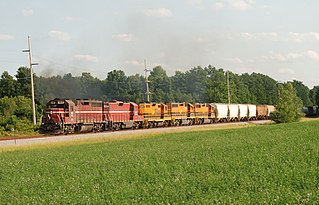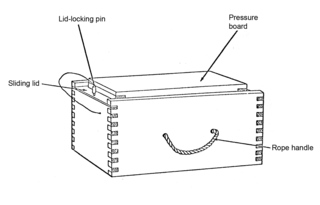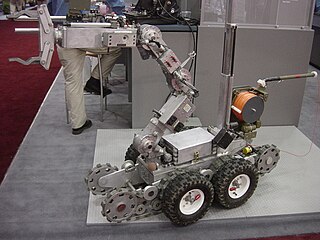
A land mine is an explosive device concealed under or on the ground and designed to destroy or disable enemy targets, ranging from combatants to vehicles and tanks, as they pass over or near it. Such a device is typically detonated automatically by way of pressure when a target steps on it or drives over it, although other detonation mechanisms are also sometimes used. A land mine may cause damage by direct blast effect, by fragments that are thrown by the blast, or by both.

The Second Battle of El Alamein was a battle of the Second World War that took place near the Egyptian railway halt of El Alamein. The First Battle of El Alamein and the Battle of Alam el Halfa had prevented the Axis from advancing further into Egypt.

The M18A1 Claymore is a directional anti-personnel mine developed for the United States Armed Forces. Its inventor, Norman MacLeod, named the mine after a large Scottish medieval sword. Unlike a conventional land mine, the Claymore is command-detonated and directional, meaning it is fired by remote-control and shoots a pattern of metal balls into the kill zone like a shotgun. The Claymore can also be victim-activated by booby-trapping it with a tripwire firing system for use in area denial operations.

The Casspir is a Mine-Resistant Ambush Protected Vehicle that has been in use in South Africa for over 30 years. It is a four-wheeled, four-wheel drive vehicle, used for transport of troops. It can hold a crew of two, plus 12 additional soldiers and associated equipment. The Casspir was unique in design when launched, providing for passive mine defence. The main armoured steel body of the vehicle is raised high above the ground, so when a mine is detonated, the explosion is less likely to damage the crew compartment and kill the occupants. The cross-section of the hull is V-shaped (V-hull), directing the force of the explosion outwards, further protecting the occupants. The vehicle also offers crew protection from small arms fire. The capabilities of the Casspir were the basis of the outline capabilities required by the U.S. Marines' for their Mine Resistant Ambush Protected or MRAP vehicle project.

Retsof is a hamlet within the census-designated places of York in Livingston County, New York, United States. The community, situated 26 miles (42 km) southwest of the city of Rochester, is off rt 63 about a mile east of rt 36

M-42 was a 45-mm Soviet light semi-automatic anti-tank gun. Its full official name is 45-mm anti-tank gun model 1942 (M-42). These guns were used from 1942 until the end of World War II.

The Riegel mine 43 or is a German steel cased anti-tank bar mine used during the Second World War. The mine is a long thin rectangle. It consists of a lower and upper metal tray, and an internal metal-cased explosive block. It uses two ZZ42 fuzes inserted into either end of the internal block, although it can be used with an additional pressure fuze on the top. The mine is similar to the Italian B-2 mine. A variant, the Riegel mine 44 was also produced with a different fuze. Approximately 3,051,400 were produced between 1943 and 1945.

A minimum metal mine is a land mine that is designed to use the smallest amount of metal possible in its construction. Typically, the only metal components are located inside the fuze mechanism which triggers detonation. Both minimum metal anti-tank and anti-personnel mines exist. Some designs contain virtually no metal at all e.g. less than a gram. This is achieved by encasing the explosive charge in a plastic, wooden, or glass body, with metallic components limited to the few small parts in the fuze which can not easily be made from other materials, such as the spring, striker tip, and shear pin. Minimum metal mines are extremely difficult to detect using conventional metal mine detectors and usually require modern techniques, such as robotic Multi Period Sensing (MPS) equipment, to identify, but it is still too difficult to find non-metallic mines. These techniques are usually restricted to well-funded international mine clearing organizations and major militaries, making minimum metal mines especially pernicious where they are encountered.

The Pak 43 was a German 88 mm anti-tank gun developed by Krupp in competition with the Rheinmetall 8.8 cm Flak 41 anti-aircraft gun and used during World War II. The Pak 43 was the most powerful anti-tank gun of the Wehrmacht to see service in significant numbers, also serving in modified form as the 8.8 cm KwK 43 main gun on the Tiger II tank, to the open-top Nashorn, and fully enclosed, casemate-hulled Elefant and Jagdpanther tank destroyers.

The TM-38 was a rectangular, metal-cased Soviet anti-tank mine used during the Second World War. The mine had a large raised rectangular central pressure plate with four reinforcing creases. When enough pressure was applied to the plate it collapses pressing down on a bolt connected to an internal lever. The lever is pulls a retaining pin from the MUV fuze, which releases the striker, which impacts the MD-2 detonator.

Tiger is a former populated place in Pinal County in the U.S. state of Arizona. The town was settled as Schultz around 1881 in what was then the Arizona Territory, then later reestablished as Tiger after World War I.

The TS-50 is a 90 mm (3.5 in) diameter circular Italian blast resistant minimum metal anti-personnel mine designed and produced by Valsella Meccanotecnica.

The CC 48 is an Italian wooden cased minimum metal anti-tank mine that was used during the Second World War. The mine uses a shaped TNT explosive charge to produce a directional cutting effect. The mine uses two PMC/43 fuzes, but these can be replaced with PMC/42/2 anti-personnel fuzes, combined with weakening the lid this can make it sensitive enough to be detonated by the weight of a mine.

The CS 42/3 is an Italian wooden cased anti-tank mine used during the Second World War. Like the earlier CS 42/2 mine it uses four PMC 43 fuzes. It is a minimum metal mine, containing no metal.

The 13.2 mm Hotchkiss machine gun was a heavy machine gun designed and manufactured by Hotchkiss et Cie from the late 1920s until World War II when it saw service with various nations' forces, including Japan where the gun was built under licence.

The ANDROS is a series of remote control military robots designed by REMOTEC, a subsidiary of Northrup Grumman. The ANDROS series is primarily designed for military, explosive ordnance disposal (EOD), and law enforcement or SWAT applications. The ANDROS gained notability in 2016 for being involved in the first instance of a robot being used to kill another person, Micah Xavier Johnson, the gunman involved in the 2016 shooting of Dallas police officers.

The Holzmine 42 was an anti-tank mine that was developed by Germany and used by the Wehrmacht during World War II.



















